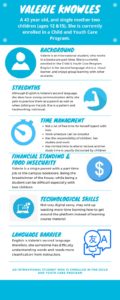
Photo by Henry & Co. on Unsplash
Here is our pod project: Distributed Equity and Perspective Project
Pod members:
- Tanvir Sidhu: tanvirsidhu.opened.ca
- Yiwei Wu: ywu.opened.ca
- Yi Yan: yyan.opend.ca
- Erin Fahey: erinfahey9.opened.ca
created by edci339 pod4

Photo by Henry & Co. on Unsplash


Note: You can right-click the image to view in a new tab
video link: flipgrid. com/59d3a48e
You may download here: IMG_5659
Description:
As a group, we decided that it would be in Valerie’s best interest to take a course in an open environment after careful consideration of her persona. So will Valerie be learning all online, face-to-face, or a combination of both?
References:
Claire Howell Major. (2015). Teaching Online – A Guide to Theory, Research, and Practice. Retrieved from http://ebookcentral.proquest.com/lib/uvic/detail.action?docID=3318874 (pp. 88-105)
Jordan, K., & Weller, M. (2017). Jordan, K. & Weller, M. (2017) Openness and Education: A beginners’ guide. Global OER Graduate Network.
What are the real and perceived barriers to learning that are preventing safe, flexible and supportive learning experiences and environments for this persona?
Valerie is a single mom who is working part-time to support her children. A “real” barrier would be her financial situation in providing food for her family. She is working, in school, and has the responsibility to take care of her children. People with multiple jobs or roles tend to be exposed to toxic stress.
The perceived variable of toxic stress could adversely affect her learning outcomes as well as not being able to afford healthy and nutritious food. As a mother, she puts her kids’ well being ahead of her own, and access to food would be no different. Further, the life of a parent needs to be flexible to cater to children’s needs. This would prevent Valerie from being able to have a flexible school and work life. Valerie would thrive in an asynchronous learning environment where she can complete work on her own time. For example, after she has put her children to bed, before her children wake up, or on a break at work. A platform that could replace physical office hours would be Zoom office hours. Since Valerie needs to have a flexible schedule she could be missing out on office hour clarification if she has work or obligations with her children in that time frame. Valerie’s children are at the age where she could have a Zoom meeting at home and they would be fine completing their own school work etc.
Valerie’s goal is to manage budgeting, school, children, and working. This goal would not be obtainable without open and distributed learning.
Open learning will enable Valerie to spend as much time working as possible. She can complete her school work outside of working hours. If she has to schedule work hours in between her physical classes she would not be able to make as much money. Valerie’s time interacting with customers at the bookstore is also crucial to her development of English. Ultimately, her language skills are fundamental to her success in school and future job opportunities.
Since Valerie is wanting to educate herself in Child and Youth Care and has children, the use of Open learning allows her to connect with the material on a deeper level. Since most likely her learning environment will be at home she can use blended learning techniques with her children and thus gain hands-on experience (Vaughan et al., 2013).
An overlooked cost to post-secondary education is textbooks but textbooks can be a significant barrier as the price can be up to $500 a term. The cost of textbooks would be a barrier for Valerie and she would benefit from open textbooks. Open textbooks would enable her to access course materials online and for free. Open textbooks are described as textbooks that are“available free of charge and free of licensing restrictions” (Mays, 2017, p. 1). For Valerie, the cost of $500 could go toward food for herself and children. It could mean that healthier options would be available.
Overall, Valerie would greatly benefit from open environment learning. She would be able to tailor her learning experience to her needs while being able to support herself and her children financially.
References
Jordan, K., & Weller, M. (2017). Jordan, K. & Weller, M. (2017) Openness and Education: A beginners’ guide. Global OER Graduate Network.
Mays, E. (Ed.). (2017). Open Pedagogy. In A guide to making open textbooks with students. Rebus Community.
Vaughan, N. D., Garrison, D. R., & Cleveland-Innes, M. (2013). Teaching in blended learning environments: Creating and sustaining communities of inquiry. AU Press. [Chapter 1]
We create an image to describe our pod persona: Valerie Knowles.

This post will appear in a few places:
Please delete this post once you understand this. If you have any questions, please reach out to your instructor.
© 2025 Distributed Equity and Perpective Project
Theme by Anders Noren — Up ↑